HMLTD cover feature – the committed, divisive, 24/7 art project is not about escapism
'Polarisation is a good indicator, if everybody likes what you’re doing unanimously, then it’s kind of a sign that what you’re doing is most likely quite boring'
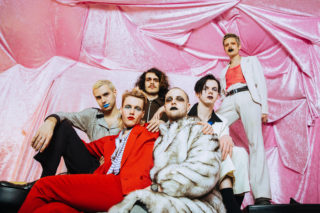
'Polarisation is a good indicator, if everybody likes what you’re doing unanimously, then it’s kind of a sign that what you’re doing is most likely quite boring'
I think what I like most about HMLTD is their commitment. For all the hype that has built up around the band over the past year within indie music circles across the capital and beyond, we’ve all seen plenty of part-timers release a couple of singles and get a bit of buzz before fading away. With HMLTD though, you get a sense of something different. You get the sense that they’re so committed to their art as to be indistinguishable from it. You get the sense that they’re the real fucking deal.
It’s easy to be cynical in the world of music journalism – you interview and see so many bands and shows that you can end up feeling somehow above or removed from it all. Turning up to interview a band and seeing them dressed up like some mutation of Adam and the Ants and Judas Priest, you could easily laugh to yourself. “Silly kids, eh?” Witnessing them live with their singer dressed up in a PVC body suit, you could maybe have another chuckle to yourself.
Only, the joke would be on you. All the best music that I know has come from a place of complete commitment to an artistic vision, with no room for self-preservation. The reason why David Bowie was so inspiring was that he effectively lived his art – his chameleon-like transformations borne out not only through his music but his image, his fashion and at times even his lifestyle.
To my mind, HMLTD subscribe to a similar artistic worldview, at a time when it’s been done before – a whole new challenge in itself. Theirs isn’t so much a band as it is a 24/7 art project. In front man Henry Spychalsk they have a living embodiment of their music. The rest of the band are equally committed. When I head along to watch a show of theirs after speaking to the group, I catch Henry and he proudly explains how the band spent the day painstakingly decorating the stage of the bar that we’re in to make sure it properly complements their music. HMLTD are signed to Sony – they don’t really have to give a shit – but they still care immensely about the presentation of their art, even in a small South London pub.
Whether you like their music or not, you’ll have to decide for yourself, but you can’t possibly doubt the dedication of HMLTD to what they’re doing.
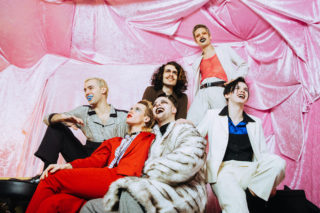
I meet the band in their fulltime recording space in Shoreditch. It’s a cosy multi-level unit, with a studio downstairs and a spit-and-sawdust bar area upstairs. My head swirls as we shake hands and I drink in each of their trash-chic outfits before we sit down. One guy is in military garb, another is in a zoot suit, and everyone seems to be wearing make-up. Shirt and jeans was the wrong call today, and I feel severely underdressed.
First, let’s cover the basics. There are six guys in the band, all in their early-to-mid-twenties. Henry handles vocal duties. Achilles and Duke – sat on the sofa with Henry today – take care of drums and samples, then guitars and risers respectively. The rest of the group are James (guitar), Nico (bass) and Zac (keys).
I ask where everyone is from and how they got to the band, but nobody seems keen on giving any straight answers. I press the issue and, with a palpable sense of reluctance, Henry sort of addresses the question. “I didn’t really ever stay in one place; I moved around a lot, so I lived in various parts of the country,” he says. “Then I moved to London with the intention, primarily, of finding something like this and finding like-minded people to collaborate with. None of us actually came from London – we all came from elsewhere seeking a similar thing and we kind of found each other.”
Henry is blond, handsome and all of 21 years old. It’s hard to avoid his eyes as he answers questions and he speaks with what sounds like a posh Home Counties accent, but he’s not giving much away. Duke playfully asks whether it’s true that Henry was adopted. “Er, no,” the singer replies – right before spilling coffee all over himself. “For fuck’s sake!” He’s now cross.
“I come from Paris,” Duke continues. “I moved to London looking for a band because the music scene in Paris is dead.” Henry mutters something about everything in Paris being dead while he attends to the fresh stain on his shirt, but Duke demurs. “No, I mean it’s a very beautiful city, there’s just nothing much going on.”
Achilles is Greek and moved here when he was 18. He took the scenic route towards joining HMLTD. “I wasn’t looking for a band per se but I found that was the best way for me to do what I wanted to do. I studied a lot and read a lot and I tried to approach this through other art forms but then I found that this specific band is the best way, due to the people who are in it right now. Everyone shares the same vision so that we can do what we do.” James, Nico and Zac were also drawn from across Europe.
The six might have only been playing together not much longer than a year but it’s fair to say there can’t be many new bands in London who’ve made a bigger impact. Two singles have emerged – ‘Is This What You Wanted?’ and ‘Stained’ – which both show off a Molotov cocktail of gothic post-punk, glam rock and industrial music; think something along the lines of Bauhaus and Gary Glitter via Nine Inch Nails.
All the same, Achilles drives home the future-centric focus of the band. “When you reflect on the world, you start from the past. Ignoring that would be escapist and appropriating would be retrospective. A middle path would be to channel that to move forwards. We don’t want to go backwards.”
“It would be completely naïve to deny, you know, that we take influences from the past – certainly we do – but it’s not done in a retrospective manner and it’s not done in a revivalist manner,” Henry says. “The only point at which we look backwards is to propel ourselves forwards. I think there is a general tendency in some genres to kind of create music based purely on listening to past music. [But] if you do that then all you’ve really come up with is a pastiche, because you’re not placing it in any kind of context.”
Henry certainly recognises the importance of broader context in how HMLTD make their music. “If you want to create something which isn’t kind of like alienated from your present context, then you need to pay attention to everything that’s going on around you. Not just listening to music but you know, pay attention to the surrounding world. You can’t just listen to music to create music that’s relevant.”
The bands’ live shows have been explosive affairs. Witnessing them play myself, I was struck by the confrontational interplay between Henry up on stage preening over the crowd, and the frenzied mosh pit below. “I think performance has to be confrontational,” Achilles argues. “Otherwise it’s not performance. Like in a play or in anything where someone is putting themselves in a position to be seen, you have to react to the person watching you. Because we’re very keen on what we want to say, we are also aggressive about it. We don’t adulterate the message.”
Gigs have also been notoriously polarising, at least in the early days. “At one of the first shows we played, we started to a full, packed room,” Duke recalls. “Probably by the end of the show half of the room was empty. I just remember thinking this means that we’re doing something exciting.” Henry is more direct. “We want to force a change. Changes come about like that.” (More recently, when we told a friend of Loud And Quiet that HMLTD were going to be this month’s cover feature, she said: “I saw them play – I didn’t think I could hate a band that much.”)
He continues: “I think polarisation is a very good indicator, in the sense that if everybody likes what you’re doing unanimously, then it’s kind of a sign that what you’re doing is most likely quite boring, or at least that it’s not challenging the audience – it’s kind of patronising them. You’re always going to end up with a full crowd at the end of the show but you’re not challenging them.”
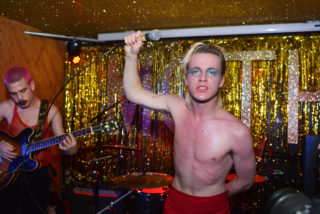
HMLTD have also obviously been playing far more songs live than they’ve actually released yet, with a repertoire of at least a dozen in regular rotation. When I last saw them, there were a couple of new additions, including the fantastically seedy ‘Apple of my Eye’. In fact, there’s such a chaotic energy to each show – from the songs to the stage performances – that I wonder whether it’s a challenge capturing it all on record.
“I think we’ve done what we wanted to do [so far],” Achilles says.
“It’s more of a question of how we want to roll it out; how we want to space it out and how we want to time it,” Henry elaborates, adding that they’ve only been playing together about a year. “I don’t think there’s any real issue translating the live chaos into the record,” he says. “I think that’s what we attempted to do – I think quite successfully – with the singles.”
Speaking of which, ‘Stained’ caused quite the stir when it was released in November of last year, not least because of its genuinely disturbing video – which we’ll get to in a moment. Lyrically, it turns out that the song is effectively all about moralistic corruption and nihilism. Supposed totemic pillars of morality are undermined throughout the song, with Henry taking aim at everybody from his parents to – yes, really – Mother Theresa. Vocally, he crows the bratty crow of Niall O’Flaherty of The Sultans of Ping FC.
The idea of the song seems to be that the notion of morality itself isn’t a valid concept – heavy stuff. “At the base level it could be most obviously interpreted as political, but that’s not really the aim of it at all,” Henry explains. “It’s more about kind of moving beyond morality and sort of going beyond good and evil, and living in this world where once you realise everyone is inherently stained, everything becomes quite useless – all attempts to be moral or whatever – and that’s quite liberating. I guess that’s the idea. That’s what we’re trying to get at in the video – it’s about freeing yourself of the shackles of morality and kind of moving into a post-moral stage where you’re completely liberated in terms of what you can do.”
Anybody who first heard ‘Stained’ via the accompanying music video could probably be forgiven for not picking up on the Nietzschean nihilism at the song’s core. The nightmare visuals put together by artist and director Jenkin van Zyl combine the grotesque and the absurd in what is certainly a bracing experience not dissimilar to a particularly gruesome horror film. Starting with zombie-like bodies emerging from blood-spattered cocoons, the video never really lets up from there, climaxing with what will probably be the most terrifying Halloween party you’ll ever witness.
“There have been a lot of interesting comments about it,” Duke laughs. “I guess what’s good about it is that it gets a reaction from people.”
Henry agrees. “It’s divided opinion, I think, quite dramatically,” he says with a smile.
So how does the horror show in the video relate to all the moralistic nihilism that we were talking about earlier? “I suppose it’s the breaking down of the objective standards of certain things – and that breaking down of objective standards of morality also pertains to everything else including beauty, such that, you know, there’s beauty in the gruesome and the violent and so forth. It’s kind of blending those in the post-moral stage, which creates something uncanny.”
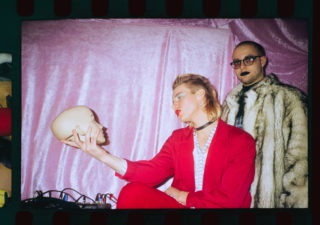
It’s clear by now that HMLTD see themselves as more than a conventional rock band, pumping out albums and touring between releases. Henry’s high-minded lyrics are obviously one indicator of this, taking in all manner of ethical, philosophical and political influences. Really though, it’s the band’s relentless focus on the visual and experiential side of their creative output that belies their grander ambitions.
Several of the band have worked in other art forms before, particularly visual arts. Henry has also done some modelling work on the side. This experience absolutely contributes to this sense of importance around the projection of the band beyond their music. “It’s not just about the music with us, it’s the whole art project, and that covers everything – the music, the aesthetics and everything,” Henry says.
Equally though, the group are generally pretty dismissive about the value of a formal arts education – I had assumed some of the band must have taken the well-trodden path via arts college but Henry bristles at the mere thought. “I feel like the idea of the academy in art is just a bit irrelevant. So yeah, none of us have, like, a formal art school background, but we don’t see this as being just about music. We kind of want to create something a lot grander, which incorporates a lot of different facets and becomes more of a complete art form.”
In terms of the message that HMLTD are trying to convey across all these different art forms, there doesn’t seem to be any kind of overarching narrative or worldview. The band don’t see themselves as avowedly political, for instance. Equally though – despite the costume and the visuals – the group definitely feel that their art stems from reality, not escapism. “Escapism would imply that you create some sort of utopia, which is the opposite of what we do,” Achilles says. “I think what we do has a lot to do with representing. For example, the ‘Stained’ video I think is a reflection [of reality] but at the same time, it’s a perverse reflection.”
One inarguable constant, though, is the sense of experimentation and fluidity across the gender axis. At times the band dress and behave with wilful disregard for gender norms; the group frequently wear make-up and embrace aspects of femininity, yet on stage the show often alternates between representing femininity and an almost aggressively macho experience. “We’re definitely interested in gender and the idea of androgyny,” says Achilles. “I think that’s again another aspect of the idea of how we view culture – and how we view certain solidified ideas that we want to break.
“For example, when we talk about ‘Stained’ we want to break down the moral. Similarly, within gender, we have our own ideas about it and how we present gender – how we present ourselves within the spectrum of gender. I mean, we’re all male, right, but I don’t think that should hinder us from being able to talk about it.”
Henry agrees. “We are very interested in gender and sexuality and that comes across in the performances and everything.”
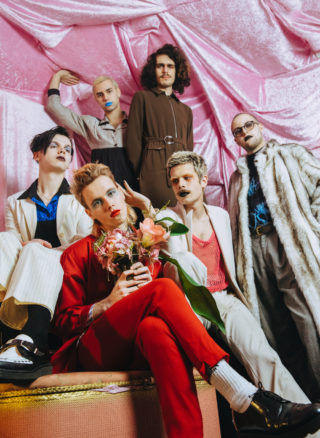
With all the buzz around HMLTD, it’s little surprise that the labels soon came calling. Last year, the sextet signed a deal with Sony. It’s a move that left many indie labels scratching their heads: how could such an outré act slot in alongside the likes of the Chainsmokers, Robbie Williams and – for God’s sake – Little Mix? A quick scan of the Sony website reveals that HMLTD aren’t even mentioned on the signed artists page, as though Sony themselves acknowledge the conundrum.
A cynic would no doubt assume that the company executives bounded into the room with briefcases of cash for an advance. The way the band tell it, though, the move happened for a couple of other reasons. The first is the label’s multimedia capabilities. “The scale of what we want to do is large,” Achilles says. “We want to keep on moving forward and widening our vision. At the same time, I think we concluded that the people at Sony got it.”
“It’s the particular individuals that we’re working with,” Henry argues, and Achilles agrees. “From the beginning, we made sure that we wouldn’t do anything was it not for a shared understanding of what we want to do,” he says. “I think we got that across and it’s been going very well so far.”
“[Signing to a big label like Sony] is a risk on both sides. That’s what keeps it exciting,” Duke laughs.
“We wouldn’t have signed anything if we’d believed it would be a creative straightjacket,” Henry argues. “Every kind of decision, we make it geared towards providing ourselves with the best platform possible for doing what we want to do.”
It’s probably safe to assume that it was ultimately at the behest of Sony that the band changed their name. It was only a matter of time before their old moniker, Happy Meal Ltd, raised the ire of Ronald McDonald’s cheerful army of intellectual property lawyers. In any case, it wasn’t a name that particularly made much sense in the first place, Henry says. “We kind of felt we needed to move away [from it] a little bit; the immediate interpretation of Happy Meal Ltd is satire and parody. With parody there comes quite an evident pedagogical ideology and we’re not really interested in pushing a pedagogy.”
Nowadays it’s basically a meaningless initialism that defines the band – an astute move from an SEO perspective but also apparently a liberating one. “HMLTD in itself means nothing,” says Henry, “so we can give it the meaning, and that’s important. We create the word’s meaning rather than having a word which is already loaded with meanings, which we can’t control.” Duke argues that people will get it later on.
With a big label now on board, I would imagine the pressure would be on to get a record out of the door, although the band insist that they’re in no rush and they’ll be going at their own pace. Likewise, gigs are relatively sparse over the next couple of months at least, although apparently the band are still at full tilt; I ask about life outside HMLTD but everybody just laughs at the idea of such a thing. “There’s none,” Henry insists. “It’s a 24/7 project. When you get home you’re still working and when you sleep, you’re still thinking about things.” The band are down working in the studio “every day,” says Achilles.
As if they don’t have enough to do themselves, the band say they could potentially spearhead a grouping of like-minded bands and people at some stage in the future. “We certainly intend to create more allies and we certainly intend to create a sort of movement,” Henry explains. “We’re not exclusive and we’re not elitist, at all. We want people to be involved.”
At the same time, Duke says people have to make an effort to engage.
“Yeah. People have to make an effort for them to be invested in something,” says Henry. “If it’s too easy to be a part of, then it requires no investment and you’ll never really feel part of it. If you want to feel part of something then you’ve got to properly invest in it, don’t you?”
It’s a fair point and, perhaps, something of a critique of the broader breakdown of people’s investment in bands, scenes and subcultures – being an armchair fan has never been easier. If HMLTD operate at such a full level of commitment to their own art, perhaps it’s fair to ask that those around them invest the time to understand and be a part of it. Certainly speaking from my own experience, I understand what HMLTD are all about far better now for having witnessed them live, for instance.
As we wrap up our interview, I ask for a tour of the studio downstairs before I say my goodbyes. We trundle down the concrete steps and emerge back in the diminutive rehearsal and recording space that they call home. There are sheets and blankets getting adhered to walls for soundproofing, there’s low-level mood lighting provided by a haphazard assortment of lamps and of course there are instruments strewn everywhere. Exciting things will be coming from the place soon.
In fact, I leave HMLTD with a broader sense of optimism. Nothing in what we’ve spoken about during our time together has disabused me of the idea that the band are thoroughly invested in their art in a manner that’s more unusual today than perhaps it once was. People like Henry and his band aren’t just dabbling with making records – they’re absolutely all-in.